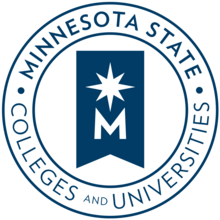
About the Collaborator
Minnesota State has 26 colleges, 7 universities, 54 campuses, serving 300K+ students with affordable, inclusive, and career-focused education.
UDI Practice Area
Design Imperative(s)
Engagement Level(s)
Institution(s)
How can a higher education system serving over half of its state’s undergraduate population become more accessible to underserved communities?
Minnesota State Colleges and Universities System (Minnesota State) is tackling this challenge head-on through Equity 2030, a strategic vision aimed at closing educational equity gaps across its 33 institutions while strengthening the state’s workforce.
To accelerate progress, Minnesota State partnered with the University Design Institute (UDI) through its Design Accelerator program, funded by a grant from the Kern Family Foundation. Launched in June 2024, the collaboration brought together Bemidji State University, Minnesota State University Moorhead, and Metro State University to develop targeted solutions for one of higher education’s most pressing challenges: transfer student success.
"With all these projects you saw that there was bold leadership, the ability to want to break down siloes that we've traditionally seen in higher education to really think differently to be more student centered and at the end of the day, supporting our students," said Satasha Green-Stephen, Senior Vice Chancellor for Academic and Student Affairs for the Minnesota State Colleges and Universities System.
Designing Innovative Solutions
The Design Accelerator guided teams through a structured process based on UDI’s IMPACT Framework and concepts from Principled Innovation. Over six months, teams engaged in hands-on design sessions, collaborated with experts, and developed pilot programs tailored to their institution’s unique needs.
The resulting pilot programs include:
- Bemidji State University & Northwest Technical College - Developing a Transfer Navigator, a multi-channel initiative to provide students with clear transfer pathways and support through partnerships with local colleges.
- Metro State University, Saint Paul College & Minneapolis College - Leveraging AI-driven equitable course equivalencies to simplify credit transfers and keep degree mapping current through the National Association of System Heads (NASH) initiative.
- Minnesota State University Moorhead - Improving transfer student onboarding and communication by implementing preliminary credit evaluations, interactive onboarding experiences, and personalized course completion roadmaps.
“At Bemidji State University and Northwest Technical College, transfer students are essential to who we are and who we serve," said Bemidji State University President John Hoffman. "Through the Design Accelerator, we developed a Transfer Navigator initiative to strengthen pathways from our regional two-year colleges and advanced new partnerships with Tribal Colleges that reflect our deep commitment to American Indian student success. Our efforts are grounded in the vision of Equity 2030 and rooted in the spirit of the North — collaborative, student-centered, and future-focused.”
The Transfer Student Challenge
For many students, transferring from a community college or between institutions is a difficult process. Nationally, only 16% of community college students complete a bachelor’s degree within six years. Within the Minnesota State system, that number drops to 12%—and just 8% for Black, Indigenous, and People of Color (BIPOC) students.
Each of the three participating institutions focused on improving the transfer process to increase student retention, graduation rates, and workforce readiness.
Scaling Impact & Long-Term Benefits
Each institution received seed funding to launch its pilot program, reducing barriers to implementation. Over the next year, the University Design Institute will continue to provide guidance, track progress, and evaluate outcomes.
Beyond the immediate impact, this initiative has trained Minnesota State’s design teams in higher education transformation. Team members will join UDI’s Community of Practice, a global network of change-makers working to reshape education.
By addressing transfer barriers, Minnesota State is taking a significant step toward creating a more accessible, equitable, and workforce-ready higher education system — that better addresses student needs and prepares the workforce for the 21st Century.
"With all of these projects, and why they're successful, all the teams were bold enough to question tradition, what traditionally should happen in higher education, and brave enough to break down siloes," Green-Stephen added. "You've seen partnerships between our two-year institutions and four-year institutions, and thinking differently about supporting our students. And lastly, being visionaries. Being visionary enough to center education around resilience and equity for our students."
